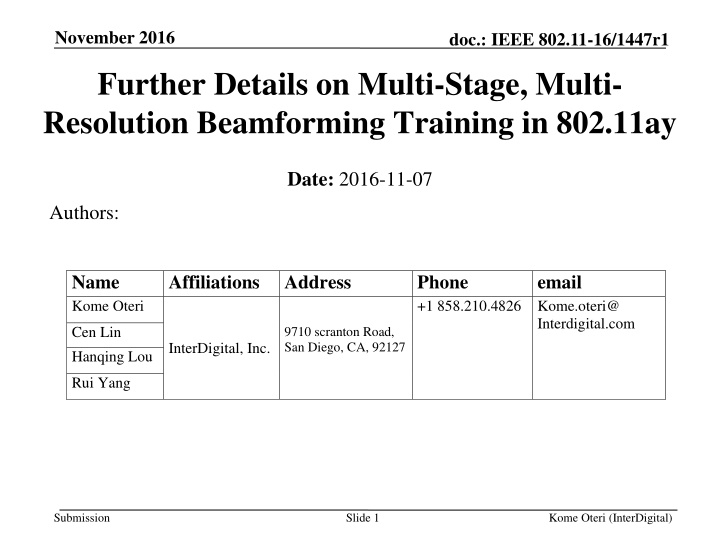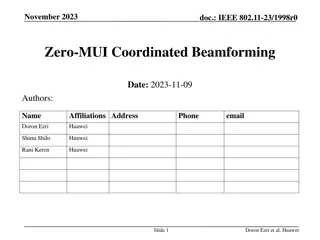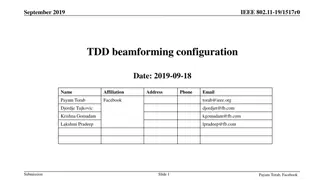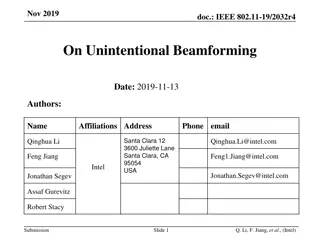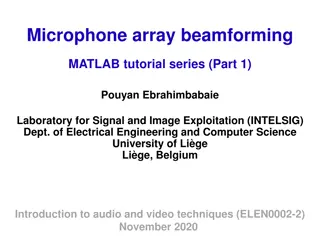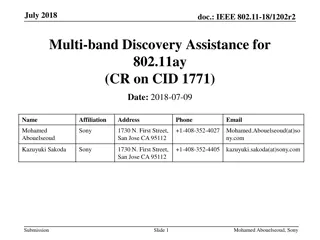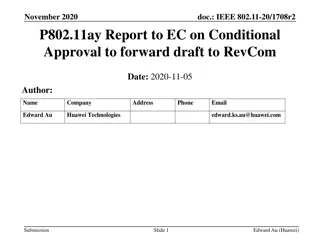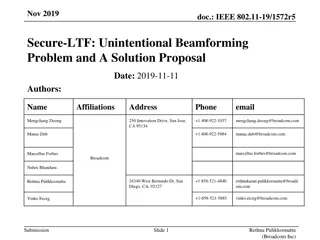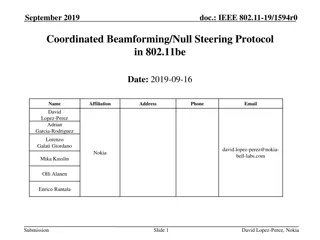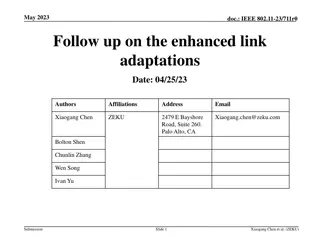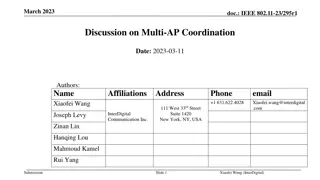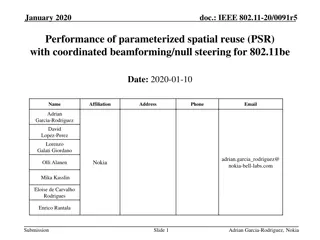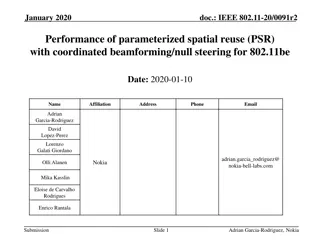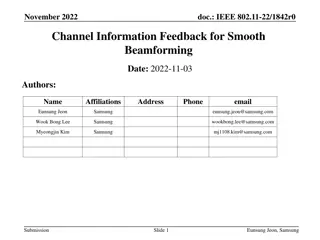Enhancements in Multi-Stage Beamforming Training for IEEE 802.11ay
IEEE 802.11ay introduces improvements in beamforming training procedures for efficiency and MIMO support. The multi-stage, multi-resolution beamforming training framework enhances beamforming efficiency with high-resolution beams. The proposal includes a Sector Sweep frame and support for up to 2048 sectors, enabling the use of massive arrays for improved training procedures. The framework utilizes varying angular resolution beams at different stages, improving the overall beamforming process.
Uploaded on Sep 17, 2024 | 0 Views
Download Presentation

Please find below an Image/Link to download the presentation.
The content on the website is provided AS IS for your information and personal use only. It may not be sold, licensed, or shared on other websites without obtaining consent from the author.If you encounter any issues during the download, it is possible that the publisher has removed the file from their server.
You are allowed to download the files provided on this website for personal or commercial use, subject to the condition that they are used lawfully. All files are the property of their respective owners.
The content on the website is provided AS IS for your information and personal use only. It may not be sold, licensed, or shared on other websites without obtaining consent from the author.
E N D
Presentation Transcript
November 2016 doc.: IEEE 802.11-16/1447r1 Further Details on Multi-Stage, Multi- Resolution Beamforming Training in 802.11ay Date: 2016-11-07 Authors: Name Kome Oteri Affiliations Address Phone +1 858.210.4826 Kome.oteri@ email Interdigital.com Cen Lin Hanqing Lou 9710 scranton Road, San Diego, CA, 92127 InterDigital, Inc. Rui Yang Submission Slide 1 Kome Oteri (InterDigital)
November 2016 doc.: IEEE 802.11-16/1447r1 Introduction In 802.11ay, enhancements to the 802.11ad beamforming training procedures have been agreed on for complexity reduction, efficiency and to enable MIMO BF training [1][2][3][4]. In [6], we proposed a multi-stage, multi-resolution beamforming training (MR BFT) framework to further increase the BF training efficiency in scenarios with high resolution beams. In this contribution, we study the implementation of MR BFT by using the 802.11ad Beam Refinement Protocol (BRP) and propose improvements to the BRP procedure to enable efficient MR BRP. Submission Slide 2 Kome Oteri (InterDigital)
November 2016 doc.: IEEE 802.11-16/1447r1 Multi-Stage, Multi-Resolution BFT 802.11ay has agreed to support up to 2048 sectors with the proposal of a new short Sector Sweep (SSW) frame to allow for the use of massive arrays [4]. To further increase the efficiency of the beamforming training procedure with high resolution beamforming, we propose that 802.11ay support the use of a multi-stage, multi-resolution beamforming framework [5]. In this framework, beams of increasing angular resolution can be used at different stages of the sector sweep, beam refinement or tracking procedure. Submission Slide 3 Kome Oteri (InterDigital)
November 2016 doc.: IEEE 802.11-16/1447r1 Multi-Stage, Multi-Resolution BFT L0: Sector Level Sweep: Identify Sector of angular spread 90 degrees L1: BFT Level 1: 4 beams per sector with angular spread 22.5 degrees L2: BFT Level 2: 4 beams per beam Level 1 or 16 beams per sector with angular spread 5.625 degrees L3: BFT Level 3/ Non-hierarchical BRP: 4 beams per beam Level 2 or 64 beams per sector with angular spread 1.046 degrees. Submission Slide 4 Kome Oteri (InterDigital)
November 2016 doc.: IEEE 802.11-16/1447r1 Example Sector Index beam Index 1 2 3 4 5 6 7 8 9 10 11 12 13 14 15 16 17 18 19 20 21 22 23 24 25 26 27 28 29 30 31 32 33 34 35 36 37 38 39 40 41 42 43 44 45 46 47 48 49 50 51 52 53 54 55 56 57 58 59 60 61 62 63 64 Feedback beam Index 19 Beam = Sector 1, beam 19 Single Resolution beam sweep : 64 beam sweeps and 1 feedback frame Resolution Index 1 Resolution Index 2 Resolution Index 3 Resolution Index 4 Sector Index L1 Index beam Index 1 2 3 4 5 6 7 8 9 10 11 12 13 14 15 16 17 18 19 20 21 22 23 24 25 26 27 28 29 30 31 32 33 34 35 36 37 38 39 40 41 42 43 44 45 46 47 48 49 50 51 52 53 54 55 56 57 58 59 60 61 62 63 64 1 1 1 1 1 1 1 1 1 1 1 1 1 1 1 1 2 2 2 2 2 2 2 2 2 2 2 2 2 2 2 2 3 3 3 3 3 3 3 3 3 3 3 3 3 3 3 3 4 4 4 4 4 4 4 4 4 4 4 4 4 4 4 4 Feedback L1 index = 2 L2 Index beam Index 1 1 1 1 2 2 2 2 3 3 3 3 4 4 4 4 17 18 19 20 21 22 23 24 25 26 27 28 29 30 31 32 Feedack L2 Index = 1 L3 Index beam Index 1 2 3 4 17 18 19 20 Feedback L3 Index = 3 Beam = Sector 1, L1:beam 2, L2:beam 1, L3:beam 3 Multi-stage, Multi-resolution beam sweep: 12 beam sweeps and 3 feedback frames Submission Slide 5 Kome Oteri (InterDigital)
November 2016 doc.: IEEE 802.11-16/1447r1 Advantages of MR BFT The overhead due to training can be reduced. This is important especially in massive, multiple antenna scenarios where multiple transmit-receive pairs are needed. The procedure can also be combined with beam down-selection. It allows for the interruption of the BFT procedure at anytime This allows flexibility in case of a BI boundary, allocation boundary etc. It also ensures that a connection between the transmitter-receiver pair can be made without the need to sweep through all the beams. The initiator or responder can request training at a particular resolution level and dynamically trade-off BFT efficiency and beam accuracy. A node can request for BFT with a resolution fallback in case of a change in the channel which is advantageous for beam tracking Submission Slide 6 Kome Oteri (InterDigital)
November 2016 doc.: IEEE 802.11-16/1447r1 Implementation of MR BFT using 802.11ad BRP Multi-resolution (three levels) Transmit beam refinement training request, TX-TRN-REQ=1, Receive beam refinement Req, L-RX=0, TRN-T field present 3 TX-training frames with 4 sectors each 3 feedback frames No TRN-R TRN-T including AGC Initiator SIFS/BRPIFS Responder Time TX train response, TX-TRN-OK=1, TX-Train-response=1, Transmit train request, TX-TRN-REQ=1 Receive beam refinement Req, L-RX=0, BS-FBCK Single-resolution (one level) Longer TRN-T 1 TX-training with 64 sectors 1 feedback frame TRN-T Initiator SIFS/BRPIFS Responder Time Submission Slide 7 Kome Oteri (InterDigital)
November 2016 doc.: IEEE 802.11-16/1447r1 Implementation using 802.11ad BRP (ctd) PPDU Format Submission Slide 8 Kome Oteri (InterDigital)
November 2016 doc.: IEEE 802.11-16/1447r1 TxOP Comparison Assumptions Tc=0.57 ns MAC data=42 Bytes (assumes no channel measurement feedback) Using any MCS would lead to a codeword less than the minimum block requirement Zero padding to aBRPminSCblocks=18 (this affects BRP_training frame size) AGC and TRN-T Training length N:1<= N<= 32 (N~5 bits) AGC=4N*64*5=1280N TRN-T=(CE+TRN_subfield*4)*N=(1024+128+128*5*4)*N=3712N IFS (Interframe spacing) At least a SIFS interval and at most a BRPIFS interval to ensure sufficient time for the complete transmission of frames SIFS=3 us; BRPIFS=44 us Analysis will compare SR BRP with MR BFT Vary number of beams and MR levels: 16 beams ( 2 level), 64 beams (3 level), 256 beams (4 level) Note: 802.11ad BRP packet supports up to 32*4=128 beams. However, we assume 256 beams can be trained within one packet here. Otherwise, two separate BRP training packets are needed for SR Study effect of IFS (3 usec <= IFS <= 44 usec) and BRP_training size (1 <= SCBlock <= 18) Assume BRP feedback frame size will stay the same Submission Slide 9 Kome Oteri (InterDigital)
November 2016 doc.: IEEE 802.11-16/1447r1 TxOP Comparison Multi-resolution beamforming training TXOP_SIFS=# of levels*(BRP_training+SIFS+BRP_feedback+SIFS)-SIFS TXOP_BRPIFS=# of levels*(BRP_training+BRPIFS+BRP_feedback+BRPIFS)-BRPIFS Single-resolution beamforming training TXOP_SIFS=BRP_training+SIFS+BRP_feedback TXOP_BRPIFS=BRP_training+BRPIFS+BRP_feedback Observations Multi-resolution beamforming training has a shorter training packet but a larger number of training and feedback packets IFS, BRP_training and BRP feedback have impact on the time duration Submission Slide 10 Kome Oteri (InterDigital)
November 2016 doc.: IEEE 802.11-16/1447r1 Results 2-Level Results: 16 beams 3-Level Results: 64 beams MR BFT with existing BRP parameters Parameters BRP_training size: 1 <= SCBlocks <=18 IFS duration: SIFS (3) <= IFS<=BRPIFS (44) Observation As resolution increases, MR BFT shows improved performance over SR BFT if BRP_training size and IFS are modified 4-Level Results: 256 beams Submission Slide 11 Kome Oteri (InterDigital)
November 2016 doc.: IEEE 802.11-16/1447r1 Results Summary Metric: uSec BRP_training Size numSC Blocks = 18 IFS 2-Level 45.63 29.85 -15.78 3-Level 69.9 63.99 -5.91 4-Level 94.25 200.6 106.35 MR TXOP_SIFS (3) SR TXOP_SIFS (3) Difference MR TXOP_xIFS (23) SR TXOP_xIFS (23) Difference 105.6 49.85 -55.75 169.9 83.99 -85.91 234.3 220.6 -13.7 Observations Observation 1 (O1): Optimizing both IFS and BRP training frame size show improvements for both SR and MR BFT. SR drops from 241 usec to 215 usec MR drops from 381 usec to 213 usec Observation 2 (O2): MR BFT shows improved performance over SR BFT as the beam resolution increases Note that up to 2048 beams may be supported MR TXOP_BRPIFS (44) SR TXOP_BRPIFS (44) Difference 168.6 70.85 -97.75 274.9 104.99 -169.91 381.3 241.6 -139.7 numSC Blocks =9 MR TXOP_SIFS (3) SR TXOP_SIFS (3) 35.12 25.6 -9.52 58.74 59.74 1 73.24 195.3 122.06 O1 MR TXOP_xIFS (23) SR TXOP_xIFS (23) Difference 95.12 44.6 -50.52 154.2 78.74 -75.46 213.2 215.3 2.1 O2 MR TXOP_BRPIFS (44) SR TXOP_BRPIFS (44) Difference 158.1 65.6 -92.5 259.2 99.74 -159.46 360.2 236.3 -123.9 numSC Blocks =1 MR TXOP_SIFS (3) SR TXOP_SIFS (3) 25.78 19.93 -5.85 40.17 54.07 13.9 54.56 190.7 136.14 MR TXOP_xIFS (23) SR TXOP_xIFS (23) Difference 85.78 39.93 -45.85 140.2 74.07 -66.13 194.6 210.7 16.1 MR TXOP_BRPIFS (44) SR TXOP_BRPIFS (44) Difference 148.8 60.93 -87.87 245.2 95.07 -150.13 334.6 231.7 -102.9 SR < MR MR < SR Submission Slide 12 Kome Oteri (InterDigital)
November 2016 doc.: IEEE 802.11-16/1447r1 Desired Updates to 802.11ad BRP Implementation of multi-resolution BF training using existing BRP protocol: Not very efficient due to aBRPminSCblocks and IFS Could be improved by reducing aBRPminSCblocks This implies the introduction of a short BRP frame design Could be improved by allowing for a smaller maximum BRPIFS This may be possible due to improved hardware compared to 802.11ad To allow for backwards compatibility, the maximum BRPIFS may be signaled. Need for standardized method of identifying resolutions/groups for tracking The resolution/group may be signaled during the BRP procedure or during feedback. Submission Slide 13 Kome Oteri (InterDigital)
November 2016 doc.: IEEE 802.11-16/1447r1 Conclusion Multi-stage Multi-resolution BFT offers improvements in BF training efficiency and beam tracking for high resolution beams. Although the existing 802.11ad BRP procedure may support MR BFT, the following elements should be optimized to improve the efficiency of the refinement The BRP training frame size The IFS allowed during the procedure Signaling to enable standardized way to identify the groups Submission Slide 14 Kome Oteri (InterDigital)
November 2016 doc.: IEEE 802.11-16/1447r1 Straw Poll 1 Do you agree to add the following text into the 802.11ay SFD? 11ay should update the 802.11ad BRP procedure to improve the efficiency of Beam Refinement Submission Slide 15 Kome Oteri (InterDigital)
November 2016 doc.: IEEE 802.11-16/1447r1 Straw Poll 2 Do you agree to add the following text into the 802.11ay SFD? 11ay BRP protocol should allow negotiation of the value of aBRPminSCblocks <=18 Submission Slide 16 Kome Oteri (InterDigital)
November 2016 doc.: IEEE 802.11-16/1447r1 Straw Poll 3 Do you agree to add the following text into the 802.11ay SFD? 11ay BRP protocol should allow negotiation of the value of the BRPIFS parameter for specific modes Submission Slide 17 Kome Oteri (InterDigital)
November 2016 doc.: IEEE 802.11-16/1447r1 Straw Poll 4 Do you agree to add the following text into the 802.11ay SFD? 11ay should allow for grouping and signaling of a set of beams of a desired resolution. The specific signaling is TBD. Submission Slide 18 Kome Oteri (InterDigital)
November 2016 doc.: IEEE 802.11-16/1447r1 References 1. 2. IEEE 802.11-16/0100r3, MIMO BF Training Enhancements, Wang et. al., Jan 2016 IEEE 802.11-16/0316r0, Low Complexity Beamtraining for Hybrid MIMO, Fellhauer et. al., March 2016 IEEE 802.11-16/0420r1, BF Training for SU MIMO, Huang et. al., March 2016 IEEE 802.11-15/1358r5, Specification Framework for TGay, Cordeiro, August 2016 Noh, Song, Michael D. Zoltowski, and David J. Love. "Multi-Resolution Codebook Based Beamforming Sequence Design in Millimeter-Wave Systems." 2015 IEEE Global Communications Conference (GLOBECOM). IEEE, 2015. IEEE 802.11-16/1175r0, Multi-Stage, Multi-Resolution Beamforming Training for 802.11ay, September 2016 3. 4. 5. 6. Submission Slide 19 Kome Oteri (InterDigital)
